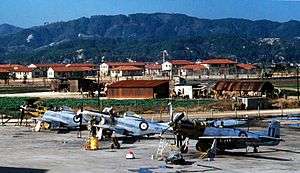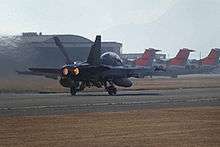Marine Corps Air Station Iwakuni
| MCAS Iwakuni | |||||||||||
|---|---|---|---|---|---|---|---|---|---|---|---|
|
MCAS Iwakuni logo | |||||||||||
|
| |||||||||||
| IATA: IWK – ICAO: RJOI | |||||||||||
| Summary | |||||||||||
| Airport type | Military | ||||||||||
| Operator | United States Marine Corps | ||||||||||
| Location | Iwakuni, Yamaguchi, Japan | ||||||||||
| Built | 1940 | ||||||||||
| In use | 1940 – present | ||||||||||
| Commander | Col Richard F. Fuerst[1] | ||||||||||
| Occupants |
Marine Aircraft Group 12 | ||||||||||
| Elevation AMSL | 10 ft / 3 m | ||||||||||
| Coordinates | 34°08′42″N 132°14′39″E / 34.14500°N 132.24417°ECoordinates: 34°08′42″N 132°14′39″E / 34.14500°N 132.24417°E | ||||||||||
| Website | www.mcasiwakuni.marines.mil | ||||||||||
| Map | |||||||||||
 RJOI Location in Japan | |||||||||||
| Runways | |||||||||||
| |||||||||||
| Helipads | |||||||||||
| |||||||||||
| Statistics (2014) | |||||||||||
| |||||||||||
.jpg)
Marine Corps Air Station Iwakuni or MCAS Iwakuni (IATA: IWK, ICAO: RJOI) is a United States Marine Corps air station located in the Nishiki river delta, 1.3 NM (2.4 km; 1.5 mi) southeast of Iwakuni Station[3] in the city of Iwakuni, Yamaguchi, Japan.
Tenant commands
US Marine Corps
- Marine Aircraft Group 12 (MAG-12) contains the rotary and fixed wing aircraft assets of Marine Corps Air Station Iwakuni. MAG-12 is home to four flying squadrons and a logistics Squadron.
- VMFA(AW)-242 — the only permanent Marine F/A-18 Hornet fighter squadron stationed abroad.
- VMGR-152 "Sumos" — moved here from MCAS Futenma commencing in June 2014 with their 15 KC-130J Super Hercules.
- HSC-25 Detachment 6 Knighthawks with 2 MH-60S helicopters which deploy to the USS Bon Homme Richard [LHD-6] as required.
- Marine Aviation Logistics Squadron 12 (MALS-12) provides logistics support, guidance, and direction to MAG-12 and other commands aboard the Station. Click on the link to the right for more information on the Marauders.
- Marine Wing Support Squadron 171 (MSW-17) provides essential Aviation Ground Support to the Station
- Headquarters and Headquarters Squadron (H&HS) provides administrative support and conducts training in general military skills for more than 800 Marines and sailors aboard MCAS Iwakuni.[5]
- Combat Logistics Company 36 (MCSL-36) Provides logistic support to MWSS-171 and MAG 12.
US Air Force
- 374th Airlift Wing 374th Communications Squadron provides communications support to H&HS, MAG-12, Branch Medical Clinic Iwakuni, Army Corps of Engineers, and the JMSDF.
Japan Maritime Self-Defense Force
- Fleet Air Wing 31[6]
- Air Patrol Squadron 71 - (US-1A), (US-2)
- Air Patrol Squadron 81 - (EP-3), (OP-3C)
- Air Patrol Squadron 91 - (UP-3D), (U-36A)
- Air Patrol Squadron 111 - (MH-53E), (MCH-101)
History
The Japanese government bought a large portion of what is today MCAS Iwakuni in 1938, with the view of establishing a naval air station. They commissioned the new base 8 July 1940. When World War II started, the Iwakuni air station was used as a training and defense base. The station housed 96 trainers and 150 Zero fighter planes on the airstrip. In September 1943, a branch of the Etajima Naval Academy was established here, with approximately 1,000 cadets undergoing training in the Basic, Junior and Senior Officer's schools at any one time. American B-29's bombed Iwakuni in May and August 1945, concentrating on the oil refinery and Rail Transport Office or train station areas. The last air raid took place just a day before the war was brought to a close.
The first allies to reach Iwakuni at the war's end were a group of U.S. Marines who had signed papers ending the conflict for the Japanese air base. After the end of World War II, various military forces from the United States, Britain, Australia, and New Zealand occupied the base and it was repaired by No. 5 Airfield Construction Squadron RAAF. It was designated a Royal Australian Air Force Base in 1948. The Americans first occupied the base in 1950 to use it as a springboard for aircraft heading to the Korean War. In 1952, the base officially became a United States military base.[7]

Iwakuni had scheduled international service by private airlines from 1952 to 1964, during which time it had the IATA airport code IWJ. This code was later reassigned to Iwami Airport in neighboring Shimane Prefecture.[8]
Nuclear weapons were moved from Okinawa to the base for storage during a brief period in 1966. When U.S. ambassador to Japan Edwin O. Reischauer learned of the presence of the weapons, which was a violation of the Treaty of Mutual Cooperation and Security between the United States and Japan, he told the United States Department of State that if the weapons were not removed within 90 days he would resign and go public with the information. The weapons were removed shortly thereafter, and their presence at the base did not become publicly known until 2010.[9]
On 14 July 1970, African-American soldiers and some anti-war soldiers raised a riot against the Vietnam War on the base.
It is currently home to around 5,000 United States Marines (including family members). The base is detailed for Marine pilot training and air patrol, using F/A-18 Hornet fighter-attack aircraft among others in compliance with the Treaty of Mutual Cooperation and Security obligations to protect Japan. MCAS Iwakuni is also shared with the Japanese Maritime Self Defense Force. MCAS Iwakuni has an air station that many people in Iwakuni want to be made into a public international airport. MCAS Iwakuni is home to a Department of Defense school, Matthew C. Perry (Elementary and High School).
The USMC's aircraft procurement plan for fiscal year 2010 revealed that the Corps plans to station 16 F-35B aircraft at Iwakuni beginning in the fall of 2015 to replace the AV-8 and F/A-18 aircraft currently stationed at the base. The F-35B's engines are louder than those of the AV-8 and F/A-18 which may affect the local community.[10]

A new off-shore runway opened at the base on 30 May 2010. The new runway is 2,440 meters in length.[11]
Since 2000, the base has killed approximately 25,000 Black Widow spiders which apparently came to the base in cargo and luggage of Americans assigned to the base. The spiders are not native to Japan, so local American and Japanese authorities are attempting to keep them from spreading beyond the base. 203 of the spiders were found and killed between October 2009 and January 2010.[12]
Plans for Carrier Air Wing 5 relocation to Iwakuni
Since at least 2005 there have been plans to relocate Carrier Air Wing Five's approximately 60 aircraft from Naval Air Facility Atsugi in Kanagawa Prefecture to Iwakuni.[13] Yamaguchi governor Sekinari Nii said there was "no way" Yamaguchi prefecture would accept this.[14] In 2006 Iwakuni voters rejected the plan in a plebiscite[15] and Iwakuni mayor Katsusuke Ihara urged Tokyo to drop the plan.[16] In 2007 the Japanese government passed legislation to prepare for the relocation of US Forces in Japan including subsidies for local affected areas.[17]
The move was planned to have been done in 2014, but after construction delays the move was delayed by three years, to 2017.[18] As of 2015 there were plans to transfer the aircraft in early 2017.[19]
Commercial services
Regular commercial service started from December 13, 2012 with a civilian airport terminal built to accommodate commercial flights. It was initially projected that up to 430,000 passengers would use the airport each year,[20] and in the first seven months of operations the airport handled over 200,000 passengers, with average load factors between Iwakuni and Tokyo exceeding 70% during June 2013.[21]
Since IATA airport code IWJ, formerly assigned to Iwakuni, was already reassigned to Iwami Airport, new IATA code of IWK was assigned to Iwakuni. The inaugural flight was operated by All Nippon Airways from Haneda Airport. Also, Iwakuni Airport will be called by its official nickname "Iwakuni Kintaikyo Airport", named after the Kintaikyo bridge near the airport. In the future, they plan to serve international flights to China and South Korea and some other cities within Japan.
Destinations
| Airlines | Destinations |
|---|---|
| All Nippon Airways | Naha (begins 27 March 2016),[22] Tokyo-Haneda |
Friendship Day

Every year on 5 May, Japanese nationals and U.S. service members, government employees and their families officially celebrate their long-standing friendship by opening the gates of MCAS Iwakuni for one of Japan's largest air shows dedicated to enhancing the friendship of the two nations. The event, entitled Friendship Day, hosts an average 250,000 visitors who travel from all over Japan.[23][24]
See also
References
- This article incorporates text in the public domain from the United States Marine Corps.
![]() This article incorporates public domain material from the Air Force Historical Research Agency website http://www.afhra.af.mil/.
This article incorporates public domain material from the Air Force Historical Research Agency website http://www.afhra.af.mil/.
- ↑ Commanding Officer : Marine Corps Air Station Iwakuni, Col Richard F. Fuerst's Biography, MCAS Iwakuni, July 20, 2016, retrieved 2016-07-31
- ↑ MCAS Iwakuni, official website. Retrieved 17 March 2010
- 1 2 AIS Japan
- ↑ "Iwakuni Airport Statistics" (PDF) (Press release). Osaka Ministry of Land, Infrastructure and Transport Civil Aviation Bureau. Retrieved 8 July 2016.
- ↑ Headquarters and Headquarters Squadron
- ↑ Air Station Iwakuni - Unit (Japanese)
- ↑ MCAS Iwakuni, Japan. (n.d.). MCAS Iwakuni History. Retrieved 17 March 2010, http://www.mcasiwakuni.marines.mil/History.aspx
- ↑ "12月開港の岩国空港略称、「IWK」に決まる". Nihon Keizai Shimbun. 28 July 2012. Retrieved 11 March 2014.
国交省大阪航空局などによると、1952~64年の間、岩国は国際空港として民間機が発着しており、このときの略称はIWJだったという。これは現在、石見空港(島根県益田市)の略称として使われている。
- ↑ Jiji Press/Kyodo News, "U.S. kept nuclear arms at Iwakuni in 1966: scholar", Japan Times, 17 March 2010, p. 1.
- ↑ Shimbun Akahata, "F-35B to be deployed to Iwakuni", 22 October 2009.
- ↑ Japan Times, "New Offshore Runway at U.S. Iwakuni Operational", 30 May 2010.
- ↑ Burke, Matthew M., and Elena Sugiyama, "Iwakuni battles to keep black widow spiders confined to base", Stars & Stripes, 7 June 2011.
- ↑ Iwakuni to take in Atsugi jets? Jun 4, 2005 Japan Times Retrieved August 10, 2016
- ↑ Yamaguchi governor rips Iwakuni move October 31, 2005 Japan Times Retrieved August 10, 2016
- ↑ Johnston, Eric Iwakuni voters reject realignment plan Mar 13, 2006 Japan Times
- ↑ Drop base plan: Iwakuni mayor March 17, 2006 Japan Times Retrieved August 10, 2016
- ↑ Diet enacts law that paves way for U.S. forces realignment May 24, 2007 Japan Times Retrieved August 10, 2016
- ↑ Air wing's move from Atsugi to Iwakuni delayed 3 years January 25, 2013 Stars and Stripes Retrieved August 10, 2016
- ↑ Reducing military jet noise August 9, 2015 Japan Times Retrieved August 10, 2016
- ↑ Japan carrier to offer Iwakuni flights
- ↑ "開港半年の岩国空港、利用は堅調". 日本経済新聞. Retrieved 5 August 2013.
- ↑ "ANA Adds New Domestic Routes in S16". airlineroute. Retrieved 10 February 2016.
- ↑ "Press Conference for 2008 Friendship Day" (Press release). MCAS Iwakuni, United States Marine Corps. 8 April 2008. Retrieved 10 June 2008.
- ↑ "Friendship Day website" (in Japanese).
External links
| Wikimedia Commons has media related to Marine Corps Air Station Iwakuni. |
- MCAS Iwakuni, official site
- An Insider's Guide to USMC Bases including Iwakuni
- Current weather for RJOI at NOAA/NWS

